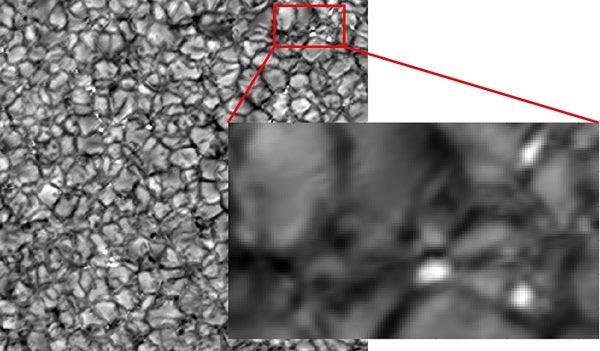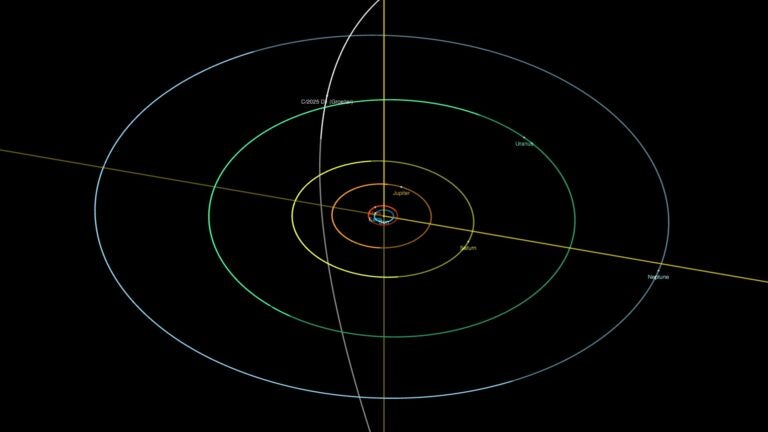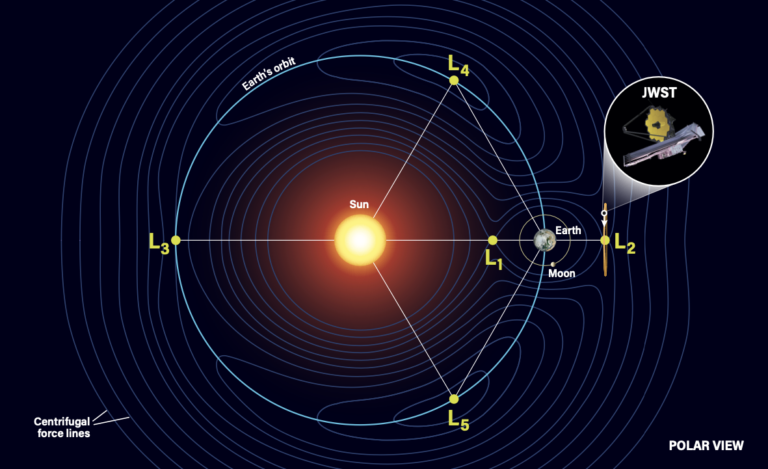Scientists from the MPS in Germany have now for the first time uncovered and characterized the smallest building blocks of the Sun’s magnetic field. In these tiny regions of only a few hundred miles in diameter, the strength of the magnetic field exceeds Earth’s magnetic field strength by a factor of approximately 3,000.
Researchers from the MPS, the Kiepenheuer-Institut for Solar Physics, and further partner institutions analyzed data gathered last year with the help of the solar observatory Sunrise. Until now, no other solar telescope was able to determine the exact properties of these structures.
The Sun is a turbulent place. Hot plasma is constantly in motion, welling up from the hot interior of our star, cooling, and sinking down again. In the photosphere, the visible surface of the Sun, these bubbling flows create net-like structures a few thousand miles in diameter. Underneath the bright, hot regions, the plasma bubbles to the surface. In the dark, cooler rims, it recedes again. Scientists refer to these patterns as granulation.
Because the kinetic energy of these flows of hot plasma can transform into magnetic energy, the currents within the Sun are closely linked to the star’s magnetic properties. One expression of this magnetic nature is the dark sunspots that can exceed Earth in size. However, the Sun’s magnetic field also consists of smaller structures. Tiny, bright points between the granules are an indicator of these fields. Within the bright points, strong magnetic fields squeeze the bubbling plasma outward so that it is possible to look deeper within the Sun’s interior. Due to the higher temperatures there, these bright points appear brighter than their surroundings.
Even though several solar telescopes are able to visualize these bright points, their physical properties such as the magnetic field strength could not be identified until now. “Without this knowledge, one of the most important requirements for a fundamental understanding of the magnetic processes within the Sun was missing,” said Sami K. Solanki from the MPS. It was like trying to study an anthill without being able to discern and describe the individual ants.
Only the solar observatory Sunrise built and operated by an international team headed by the MPS unites the crucial properties: a high spatial resolution of about 60 miles (100 kilometers) and precise instrumentation for measuring physical parameters such as the magnetic field. During the observatory’s flight in June 2009, a balloon filled with helium carried Sunrise up to a height of 22 miles (37 km) into the stratosphere. There, Sunrise had left the largest part of Earth’s atmosphere behind —the perturbing influence of air turbulence. With a main mirror of 3 feet (1 meter) in diameter, the Sunrise telescope is the largest solar telescope to leave Earth. In addition, unlike earthbound telescopes, Sunrise was also able to study the Sun’s ultraviolet (UV) radiation that is essentially absorbed by Earth’s atmosphere and doesn’t reach the ground.
“Sunrise’s instrumentation reached a resolution of 60 miles (100 km),” said Solanki. This can be compared to discerning a 1-euro coin from a distance of 19 miles (30 km). Because of this high resolution, it was possible to characterize the bright points within the photosphere for the first time. With up to 1.8 kilogauss, the magnetic field in these regions is approximately 3,000 times as strong as Earth’s magnetic field. The temperature is approximately 1,000° higher than in the areas surrounding the bright points. “Additional theoretical calculations imply that these hot magnetic structures correspond to individual magnetic flux tubes,” said Andreas Lagg from MPS. They are the building blocks of the solar magnetic field. In the photosphere, their magnetic field lines lie perpendicular to the Sun’s surface — like tubes.
Apart from that, the scientists were able to determine the brightness of the bright points for the first time — also in the UV. It is approximately 5 times higher than in the surrounding area. “With this information, it is possible to estimate the contribution of the bright points to the total radiation variability of the Sun,” said Tino Riethmuller from MPS. Since Earth’s atmosphere absorbs the UV radiation almost completely, this part of the Sun’s light plays an important role in the heating of the upper air layers. This knowledge is therefore crucial for climate research because it holds the key to discerning the man-made part of global warming from the Sun’s influences. The variation of the brightness within the photosphere, which Sunrise makes visible like no other mission before, also shows the temperature profile at the Sun’s surface.
Scientists from the MPS in Germany have now for the first time uncovered and characterized the smallest building blocks of the Sun’s magnetic field. In these tiny regions of only a few hundred miles in diameter, the strength of the magnetic field exceeds Earth’s magnetic field strength by a factor of approximately 3,000.
Researchers from the MPS, the Kiepenheuer-Institut for Solar Physics, and further partner institutions analyzed data gathered last year with the help of the solar observatory Sunrise. Until now, no other solar telescope was able to determine the exact properties of these structures.
The Sun is a turbulent place. Hot plasma is constantly in motion, welling up from the hot interior of our star, cooling, and sinking down again. In the photosphere, the visible surface of the Sun, these bubbling flows create net-like structures a few thousand miles in diameter. Underneath the bright, hot regions, the plasma bubbles to the surface. In the dark, cooler rims, it recedes again. Scientists refer to these patterns as granulation.
Because the kinetic energy of these flows of hot plasma can transform into magnetic energy, the currents within the Sun are closely linked to the star’s magnetic properties. One expression of this magnetic nature is the dark sunspots that can exceed Earth in size. However, the Sun’s magnetic field also consists of smaller structures. Tiny, bright points between the granules are an indicator of these fields. Within the bright points, strong magnetic fields squeeze the bubbling plasma outward so that it is possible to look deeper within the Sun’s interior. Due to the higher temperatures there, these bright points appear brighter than their surroundings.
Even though several solar telescopes are able to visualize these bright points, their physical properties such as the magnetic field strength could not be identified until now. “Without this knowledge, one of the most important requirements for a fundamental understanding of the magnetic processes within the Sun was missing,” said Sami K. Solanki from the MPS. It was like trying to study an anthill without being able to discern and describe the individual ants.
Only the solar observatory Sunrise built and operated by an international team headed by the MPS unites the crucial properties: a high spatial resolution of about 60 miles (100 kilometers) and precise instrumentation for measuring physical parameters such as the magnetic field. During the observatory’s flight in June 2009, a balloon filled with helium carried Sunrise up to a height of 22 miles (37 km) into the stratosphere. There, Sunrise had left the largest part of Earth’s atmosphere behind —the perturbing influence of air turbulence. With a main mirror of 3 feet (1 meter) in diameter, the Sunrise telescope is the largest solar telescope to leave Earth. In addition, unlike earthbound telescopes, Sunrise was also able to study the Sun’s ultraviolet (UV) radiation that is essentially absorbed by Earth’s atmosphere and doesn’t reach the ground.
“Sunrise’s instrumentation reached a resolution of 60 miles (100 km),” said Solanki. This can be compared to discerning a 1-euro coin from a distance of 19 miles (30 km). Because of this high resolution, it was possible to characterize the bright points within the photosphere for the first time. With up to 1.8 kilogauss, the magnetic field in these regions is approximately 3,000 times as strong as Earth’s magnetic field. The temperature is approximately 1,000° higher than in the areas surrounding the bright points. “Additional theoretical calculations imply that these hot magnetic structures correspond to individual magnetic flux tubes,” said Andreas Lagg from MPS. They are the building blocks of the solar magnetic field. In the photosphere, their magnetic field lines lie perpendicular to the Sun’s surface — like tubes.
Apart from that, the scientists were able to determine the brightness of the bright points for the first time — also in the UV. It is approximately 5 times higher than in the surrounding area. “With this information, it is possible to estimate the contribution of the bright points to the total radiation variability of the Sun,” said Tino Riethmuller from MPS. Since Earth’s atmosphere absorbs the UV radiation almost completely, this part of the Sun’s light plays an important role in the heating of the upper air layers. This knowledge is therefore crucial for climate research because it holds the key to discerning the man-made part of global warming from the Sun’s influences. The variation of the brightness within the photosphere, which Sunrise makes visible like no other mission before, also shows the temperature profile at the Sun’s surface.










